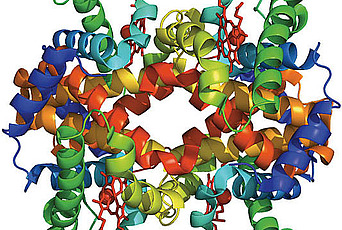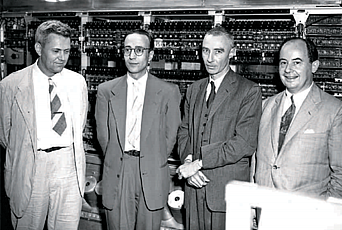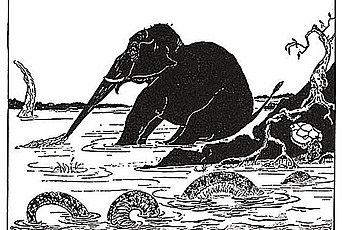Biology at the Institute for Advanced Study

This sketch of earlier attempts to bring biology to the Institute for Advanced Study is not a history. I have not dug into the archives to find official documents and exact dates. I am only recording my own fallible memories of events that I either saw for myself or heard other people talk about. Much of the information comes from my son George Dyson, who has examined the Institute archives for his forthcoming biography of John von Neumann.
Around the year 1936, long before I came here, our first Director, Abraham Flexner, invited the British biologist John B. S. Haldane to come to the Institute. This would have been a good way to start a biology program here. Haldane was a population biologist who made important contributions to the mathematical theory of evolution. He was one of the pioneers in the study of “inclusive fitness,’’ which means the additional fitness that an individual derives from sharing genes with relatives. He explained the concept by saying, “I would jump into a river to save two brothers or eight cousins from drowning.” This was because he shared one half of his genes with a brother and only one eighth with a cousin. He was, like Darwin, a theoretical biologist who did not need a laboratory for his work.
Unfortunately, when Flexner invited him, he declined the offer. The Spanish civil war was raging, and Haldane was on his way to Madrid to organize the defense of the population against poison gas attacks. He had become an expert on chemical warfare as an army officer in World War I. He taught the citizens of Madrid how to improvise gas masks out of the empty wine bottles that were the only raw material available in sufficient quantity to protect the whole population. Fortunately, Franco’s troops besieging the city never used chemical weapons, and Haldane’s wine-bottle gas masks were never tested in action.
The first theoretical biologist who came to the Institute was Nils Barricelli, who was invited by John von Neumann in 1953 and stayed here for two terms. Using the computer that von Neumann had built at the Institute, Barricelli simulated the evolution of populations of artificial organisms. Each organism was represented by a genome consisting of a string of numbers. Random mutations and sexual exchange of genes caused populations to evolve. Barricelli observed the phenomena of speciation, parasitism, and predation arising spontaneously in his computer runs. He also observed punctuated equilibrium, the tendency of dominant species to remain static for many generations and then suddenly give way to new dominant species of a different character. He was a pioneer of the new science of Artificial Life, forty years before it became fashionable. With astonishing ingenuity he was able to simulate sophisticated evolutionary processes on a machine with a total memory of four kilobytes. Von Neumann had a strong interest in biology, but he died in 1957 and never had a chance to go further along the route that Barricelli explored. After von Neumann died, the Institute computer was closed down and no more biologists were invited to use it.
As long as J. Robert Oppenheimer was Director, he made sporadic efforts to bring famous biologists here for short visits. Each of them was invited to consider staying here and starting a serious program of research in biology. I remember three of these visitors having private conversations with Oppenheimer and giving one or two public lectures. The first was Jacques Monod, a philosophical Frenchman who had discovered the Lac Operon, the first example of a pair of proteins, one excitatory and the other inhibitory, jointly controlling the activity of a gene. He told us sternly that without a working laboratory we would not be able to attract any first-rate biologist. For him, a biologist without a laboratory was a contradiction in terms. After Monod came in succession Francis Crick and James Watson, the discoverers of the double helix. They gave us the same message. We also had discussions with Jacques Fresco, who was then the chairman of the biology department at Princeton University. In the end nothing came of these efforts.
Another opportunity was missed when Joseph Atick, a young theoretical physicist who was a long-term Member in the School of Natural Sciences, switched his interest from physics to neurology. While working at the Institute he solved an important problem in neurology, finding by theoretical analysis the architecture of color-sensitive photoreceptor cells and ganglion cells in the mammalian retina that would optimize the flow of useful information through the optic nerve to the brain. The ganglion cells are the crucial organizers of the information that comes out of the photoreceptor cells. Since the input of optical information to the retina is about a hundred megabytes per second, while the capacity of the optic nerve is only about one megabyte per second, the architecture of the ganglion cells has a decisive effect on the efficiency of vision. Experimental neurophysiologists at Rockefeller University tested Atick’s theory and found it to be correct. After that, Rockefeller University offered Atick a job. The Institute made no effort to keep him here, and the chance of starting a serious program in theoretical neurology was missed.
Real progress only became possible in the 1990s, when Martin Nowak was invited to lead a group of theoretical biologists at the Institute. Nowak’s group made important contributions to the theory of the evolution of cooperation in social species, including as a special case the evolution of human language. Once again, the Institute failed to establish the group on a permanent basis. Nowak went to Harvard, where his group is now flourishing.
At long last, the Institute made a decisive plunge into biology with the opening of The Simons Center for Systems Biology, led by Arnold Levine, a full member of the Institute Faculty since 2004. Systems biology means the study of organisms or populations as dynamical systems rather than as collections of molecules. This step became possible for an Institute without a laboratory because a large part of systems biology is concerned with exploring databases rather than exploring living creatures. Massive databases contain information about genomes, chemical signaling networks, evolutionary lineages, epidemics, and ecologies. Theoretical physicists and computer scientists, whose primary skill is the mining of data from large databases, can easily transfer their expertise to problems on the frontiers of biology. The ghost of Jacques Monod, telling us that biology without a laboratory is worthless, has now been finally exorcised.
Freeman Dyson is Professor Emeritus in the School of Natural Sciences.


